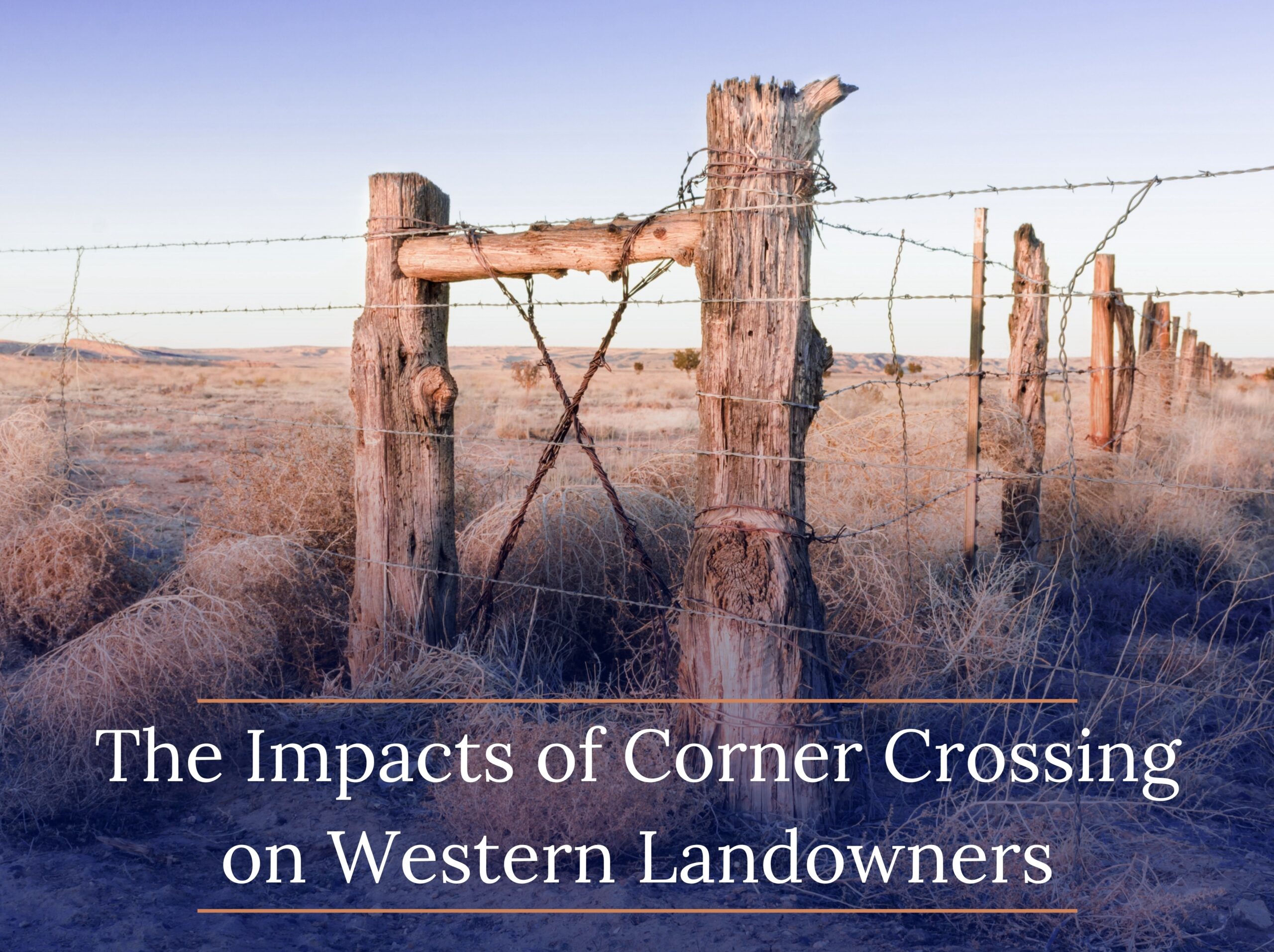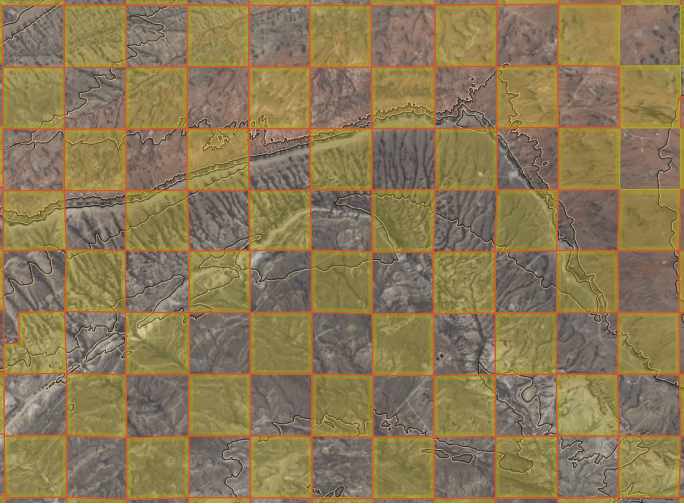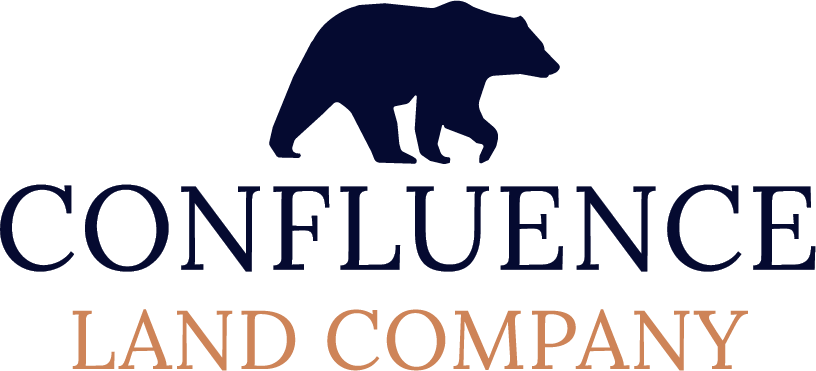The Impacts of Corner-Crossing on Western Landowners

Disclaimer: The information provided in this article does not constitute legal advice.
In recent ruling, the U.S. Tenth Circuit Court of Appeals found that “corner crossing,” or the act of stepping from a public corner of land to another public corner of land where four parcel corners meet, does not violate federal laws regarding trespass. The decision effects six states-Colorado, Kansas, New Mexico, Oklahoma, Utah, and Wyoming-and has intensified discussions around property rights, public land access, and the future of land management in the West. As a brokerage specializing in the purchase and sale of ranch properties, many of which are adjacent to such public land corners, Confluence Land Company feels this legal decision will have both unique positive and challenging ramifications on our clients moving forward. Below, we’ve provided background on the issue as well as consideration of the ruling’s effects.
What is “Corner Crossing?”
Corner crossing refers to the act of stepping from one parcel of public land to another at the intersection of four land parcels, where two are public and two are private. This often occurs in a checkerboard land ownership pattern, where public and private lands are interwoven. Below is a visual representation of the checkerboard ownership pattern that often leads to a corner crossing situation. Yellow squares denote public lands.

What Were the Laws on Corner Crossing Prior to this Ruling?
There has never been, and remains, no federal law that explicitly legalizes or outlaws the act of corner crossing between federally owned lands. Numerous corner crossing-induced trespass cases in lower-level courts have sought to clarify the legality of corner crossing. Furthermore, bills have been introduced from time to time in various Western states to either legalize or illegalize the act of corner crossing. None of those bills on either side ever passed, and legal cases were essentially handled on a case-by-case basis. In summary, corner crossing has been a legal gray area for quite some time, and the majority of public land users have thus refrained from trying it.
The argument for a corner cross being legal stems from the 1885 Unlawful Inclosures Act, which essentially prohibits the obstruction of access on or across public lands.
The argument for a corner cross constituting trespass has relied on real property laws surrounding airspace. The belief is that because landowners own the airspace above their deeded ground (up to public airspace heights), and because a property corner is infinitely small, stepping over a corner inherently enters the private property of the adjacent corners.
How Did This New Ruling Come About?
This ruling stems from a 2021 court case involving four nonresident hunters who corner crossed and were charged with both criminal and civil trespass charges. The criminal charges were dropped, but the civil case has been ongoing. The federal court hearing the civil case ultimately dismissed the charges, and the plaintiff (landowner) appealed to the United States 10th Circuit. After hearing the case, a three-judge panel of 10th Circuit Appeals judges unanimously found on March 19th that the hunters had not violated the law while conducting their crossing. If the plaintiff chooses to appeal this decision, that appeal would be heard by either the full-panel of 10th Circuit Court of Appeals judges, or the United States Supreme Court.

How Will This Affect Landowners?
This decision affects over 3 million acres of public land in the West- for each individual corner, there are two neighboring private parcels that are affected. Many landowners have expressed concerns about the potential legalization of corner crossing, and rightfully so. In their ruling, the 10th Circuit judges echoed these concerns, noting “We appreciate this may be an unsatisfying result for property owners within the checkerboard. It leaves open questions for landowners and the public alike, including who might be liable during a corner-crossing incident, and what duty of care each party owes the other.”
The most obvious ramification of this ruling is that some subsect of public land users who previously refrained from corner crossing because of its legal ambiguity may now feel they have the legal grounds to do so. This would result in people showing up on public parcels they have not been previously, and that may be in places that have an effect on the neighboring private lands and their owners. As the judges noted, the ambiguity of this ruling also comes with concerns for landowners regarding potential legal liability and efficacy. Furthermore, corner crossing could affect management practices from fencing to hunting leases to conservation initiatives and beyond.
While the concept of corner crossing is abrasive to landowners, there are positive aspects to consider. Notably, in many cases the ability to corner cross would actually open up additional public land resources to surrounding landowners as much or more so than the general public. Consider the owner of a single parcel in the first image- before, they could legally access four surrounding public parcels. Following this ruling, they may be able to access every public parcel shown.
Next, the need to establish concrete access opportunities (and prevent the increase in trespassing violations that could result from attempted corner crossing) may incentivize state agencies to increase collaborative access opportunities. These access initiatives, like Colorado’s Walk-In-Access Program, Wyoming’s Access Yes Program, or Montana’s Block Management Program, provide compensation (financial or otherwise) to landowners in exchange for allowing varying levels of public access. Moving forward, these programs could be expanded to establish some access to corner-cross eligible lands while providing landowners with legal protections and compensation. More intensive options a landowner could pursue might include a public-private land swap to negate checkerboarding.
Practically, it’s important to note that it is yet to be seen how many public land users will choose to corner cross moving forward. Even if it remains legal, corner crossing requires extremely precise navigation and pathfinding abilities to execute legally. Digital physical maps will likely not suffice- these tools and the public data they source from can be off by significant distances. Realistically, a corner crosser would need to locate the physical monument where the corner lies and cross at exactly that point, as the defendants in the court case did. With many of those monuments have been weathered, buried, or removed by time and the elements, this is a challenging proposition. If a corner-crosser misses the actual corner, that still constitutes a trespass. If corner crossing is to be a legitimate viable option for access moving forward, there will almost certainly have to be answers to the myriad of legal questions that remain outstanding. Until then, this ruling offers precedent for future corner crossing incidents, but the specifics of each attempted crossing will ultimately determine their legality.
Confluence Land Company prides itself on maintaining a comprehensive understanding of the laws, customs, and practices that effect ranch land across the Western United States. Beyond the purchase and sale of ranch land, each of our brokers is personally invested in and passionate about changes that affect the ownership and management of these ranches; we would be honored to assist in answering any questions you may have about this ruling, others like it, or any other aspect of landownership in Colorado, New Mexico, Wyoming, Montana, Nebraska, and South Dakota. Please do not hesitate to Contact Us if we can be assistance to you.
Disclaimer: The information provided in this article does not constitute legal advice.

